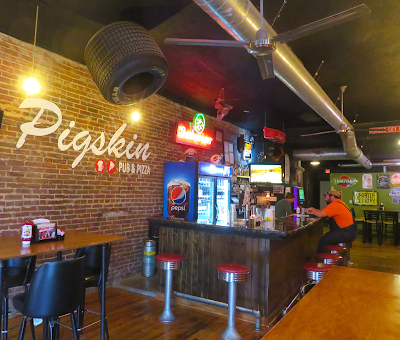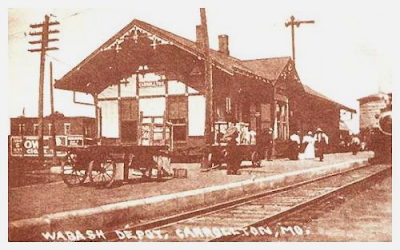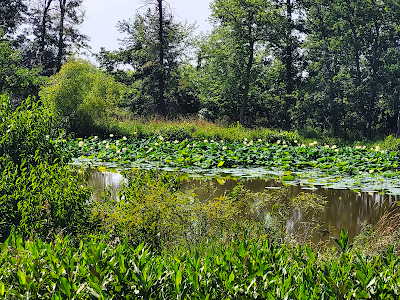…continuing with our back road adventures in Missouri, this time focusing on the northern tier of the state close to US Hwy 36, a 4-lane highway that is mostly not a limited access roadway. The speed limit is 65 mph vs. 70 on I-70 further south, but the lack of traffic and trucks plus a smoother roadbed, makes this our preferred route across Missouri to I-29 North to Iowa and Omaha Nebraska.
I’ll take
up where I left off on my last post about our road trip…in Marceline Missouri.
This post may be ‘just a bit long’, even for me.
The photo
above shows the first Marceline Santa Fe Railroad depot, a frame structure that served the down
for over 20 years.
In the
early to mid-1800s, the area where Marceline has been established was open with
farms and cattle across the prairie.
Then, one day in 1886 representatives from the Atchison, Topeka and
Santa Fe (aka the Santa Fe Railroad), turned up in the neighborhood offering
enticing prices for land, obtaining contracts as needed. In 1887, the Missouri Division Point for the
route on the line between Kansas City and Chicago was platted and, in January
1888, the first town lot was sold in the city of Marceline.
The town
was named for the wife of one of the directors of the railroad, whose Spanish
name was “Marcelina”. The city became a
boomtown almost overnight. It grew so
fast that only 6 months after that first lot sold, Marceline had 2,500
residents. Today, the city has a
population of 2,123.
This handsome new Santa Fe Passenger station and office building replaced that old frame depot. This sold brick structure was dedicated in April of 1913. At that point, Marceline had only existed for 25 years…and now it had a first class passenger depot. It had 107 windows and over 200 – 100 watt lights.
In the
early 1900s, the railroad also built a separate structure which was called “The
Reading Room”. Santa Fe employees could
go there, read books or play the piano.
It was featured in a 1909 edition of the Santa Fe railroad worker
magazine. Occasionally special
performances were staged there.
Marceline enjoyed special appearances from people like Shirley Temple,
Mae West, W.C. Fields and Clark Gable.
In return the performers would travel on the Santa Fe for free. Sadly, by the 1940s, the Reading Room was
gone…
The
Marceline Santa Fe Depot closed in the 1980s, with the last Amtrak Passenger
train stopping here at the unmanned depot in 1997. After standing empty for a couple of years,
in 1999 the depot was purchased and converted into a museum, which opened in
2001. More on that to follow... That double set of tracks is quite busy though. Three or four freight trains roared by during our visit.
The EP
Ripley Park, adjacent to the old but renovated museum, contains two pieces of
railroad equipment that are of interest to railroad fans around the
country.
This is
not a coal burning locomotive but rather an oil burning version. Locomotive #2546 is a Consolidation type
(2-8-0) engine built in 1911 by the Alco Locomotive Works for the Kansas City,
Mexico and Orient Railway. It was sold
to the Santa Fe Railroad in 1927. The
locomotive weighs almost 112 tons and the tender weighs about the same. The tender could hold 8,000 gallons of water
and 3,657 gallons of oil.
Locomotive
#2546 was donated to the City of Marceline by the Santa Fe Railroad in
1955. Note the designation painted on
the side of the tender. Walt Disney
requested that the Santa Fe and Disneyland Railroad be painted on its side… Why
would he do that?
That
little park in Marceline is also home to an EMD SD40, a 6-axle diesel-electric
locomotive built by General Motors Electro-Motive Division. Santa Fe #5008 was built in 1966.
Locomotive
#5008 had a benefactor who was intimately connected to her. Sam Baily, a retired Santa Fe and Burlington
Northern engineer singlehandedly restored this engine. Now that is a real retirement project! Sam had actually operated this locomotive as
a hostler, (an engineer who moves a locomotive between shops, rail yards and
fueling tracks), when the locomotive was only 2 years old. He was also at the throttle throughout his
career. #5008 was retired 2 months
before Sam did. Marceline was selected
as the home for this locomotive because it was once a division point for the
Santa Fe Railroad.
A modest section of the interior of the museum contains a selection of railroad memorabilia, such as the Santa Fe ‘grandfather style’ clock, the old cash register and that little step stool that would have been used when boarding passengers. The woodwork around the ticket windows has been well maintained. Love the ‘look’ of the uniform too…
There are small reminders of days past in other objects such as these Santa Fe caps. Ticket agents used to wear their caps on the job but I haven’t seen one in use for many, many years. Looking on eBay, a variety of different old railroad caps are up for sale, ranging in price from $50.00 to over $300.00.
The old
brakeman’s cap is the most interesting to me.
Their original job was to assist in the braking of a train by applying
the brakes (frequently for the roofs) on individual wagons or cars. The advent of braking systems that could be
controlled by the ‘driver’ or engineer, allowed that person to slow and stop
the train. Brakemen also provided ‘flag’
protection from following trains if his train had to stop, ensuring that
couplings were set correctly, and assisting with switching operations.
The number
of brakemen jobs continues to decline.
As of 2018, there were only 14,270 brake men or women employed in the
USA.
It’s
probably just a quirk with me but I do love old railroad and airplane china,
drink glasses and flatware. They don’t
sell for a lot but they just make me feel good.
I have a set of 8 cocktail glasses from the Burlington Northern Railroad
and one dinner knife from United Airlines.
Looking
at eBay, I noted Santa Fe Railroad dishware items with asking prices ranging
from $47.77 to $180.00. Glassware seems
to be generally lower…
But to
what does this former Santa Fe Railway Depot…now a museum…focus on that earns
it a lot of attention and visitors?
The big Mickey Mouse figure wearing a railroad engineer’s outfit at the entrance does provide a significant clue. The little bronze with Mickey and Walt Disney is yet one more clue. The old Santa Fe Depot in Marceline Missouri is now the “Walt Disney Hometown Museum”. As Walt is famous for saying, “It all started with a mouse”. More on Disney and Marceline follows in this post.
Mickey
Mouse, a world famous cartoon character, was co-created by Walt Disney and Ub
Iwerks in 1928. Mickey is almost always
characterized as a sympathetic underdog that gets by through pluck and
ingenuity despite facing challenges bigger than he is. He is one of the most recognizable and
acclaimed fictional characters of all time… Walt not only co-created Mickey but
Walt also provided Mickey’s voice in the beginning.
We aren’t
particularly enamored with Mickey Mouse, Disneyland, Disney World or
cartoons…but we both truly appreciate those who strive to build something and
who succeed even beyond their imagination.
This museum is more about Walt Disney…the boy and the man…then it is
about his cartoon characters, amusement parks or movies.
The photo
above shows Walt Disney and his brother Roy during a visit in 1956 at the Santa
Fe Railroad Depot in Marceline.
Remember
that wood frame depot at the beginning of this post? It stood on the exact same spot as the new
depot/museum stands now. It was that
depot that welcomed the Disney family when they moved to Marceline. Flora Disney arrived first with the 3
youngest children including Walt. Elias
Disney and their 2 older sons arrived a few days later in a boxcar loaded with
family belongings and 2 horses that Elias had purchased in the Chicago
stockyards.
Elias and
Flora’s children were Herbert, Raymond, Roy, Walt and Ruth. Walt was only 4 years old. At his young age, he wasn’t expected to do
much on the farm so he was able to explore and his experiences in the area
spurred his imagination. I think that the photo above may be mislabeled as Roy was older than Walt.
Main
Street in Marceline was imprinted in his memory and all Disney Parks feature a
“Main Street” attraction. His Uncle Mike
was a Santa Fe engineer and he often passed through Marceline, sparking Walt’s
love of trains. Walt also attended a
play about Peter Pan, one of his favorite stories. When Elias Disney’s health failed in 1911,
the family moved again, this time to Kansas City. But Walt never forgot Marceline and his
experiences in the area helped shape his future successes.
Walt Disney's visit in 1956 was for the dedication of a park and swimming pool named after him. He was accompanied by his wife, Lillian, Roy Disney and Roy’s wife. Walt had visited Marceline before…in 1948 when some filming was done here. He returned once again in 1960, when the town’s new elementary school was named after him.
A variety
of Mickey Mouse related items are scattered throughout the museum. If you go online and look at Mickey Mouse eBay
collectables, there are more pages than I have the patience to go through. As a youngster in the 1950s and into the mid-1060s,
I can’t say that I’ve ever seen a bicycle like this one…
The Walt
Disney Hometown Museum opened in 2001, just in time to celebrate Walt Disney’s
100th birthday. The museum’s
displays were built using the personal collection of Ruth Disney Beecher, Walt’s
younger sister. She had been close with
both Walt and Roy and she knew how fondly they remembered the hometown of their
youth.
This is
an original Mark I Arrowflite Tracked Junior Automobile. It was built as part of the Midget Autopia
Ride built for Disneyland (CA) in 1956.
The cars on this ride ran on a center rail and kids got the illusion
that they were steering it. That ride
was closed for a new ride in 1966. Walt
gave this auto to Marceline along with remnants of the ride which were
installed in the town’s EP Ripley Park.
Eventually, it was taken down and this car has been preserved.
This is
one of the rooms displaying Disney artifacts.
Walt himself presented that Mickey flag to the city in 1960.
The Walt
Disney Hometown Museum covers 10,000 square feet and it includes over 4,000
Disney related artifacts that don’t exist elsewhere. Included are: personal family artifacts
donated by the Disney family; family letters; original artwork by graffiti
artist Arcy, including a portrait of Walt; information on “The Marceline
Project”, Walt’s plan to build a live history park in town; a Collector’s
Gallery with items loaned and donated by Disney collectors from around the
world, and; memorabilia from the premiers of 2 Disney movies that were first
screened in Marceline. Those movies were
“The Great Locomotive Chase” in 1956 and, “The Spirit of Mickey Mouse” in 1998.
Laurie
does own a few old dolls but nothing like these early Mickey Mouse dolls from
the 1930s. I found one on-line with an
asking price of $1,995.00.
When Walt
Disney visited Marceline in 1960 in order to dedicate the new elementary school,
he also donated custom playground equipment and he had legendary Disney
animator Bob Moore create murals throughout the school with some of the most
famous Disney characters. Those murals
are restored on a regular basis and are still there for the school children every day.
Over the years, Walt Disney had repeatedly
related that the Coca-Cola Building in Disneyland was modeled after the Zurcher
building in Marceline Missouri. For
years the connection between Coca Coal and that structure had never been quite
understood or verified.
It turned out that Albert Zurcher had constructed
an apartment annex behind his jewelry store in 1919. When that annex burned to the ground in 2002
and the debris was taken away, the ‘lost sign’ that Walt would have seen as a
child was discovered.
In late 2015, Coca Cola sent a team of artists to
Marceline and they restored the historic “Coke” wall. A company historian thought that it was
probably originally painted in 1906, the year that the Disney family moved to
Marceline. Note the advertisement for Hutcheson’s
Furniture and Undertaking above the Coke Sign.
Roy and Walt made a little money cleaning the company’s horse drawn
hearse. As per Walt’s memories, Roy did
all the work while Walt laid inside the hearse and played dead.
There is even more about Walt Disney and the influence that his time in Marceline had on him…but this post is way too long already. If you made it to the end and read all of this, I’m impressed! To learn more about this museum, go to Walt Disney Hometown Museum (waltdisneymuseum.org).
Just click on any of the photos to enlarge them…
Thanks for stopping by for a longer than usual
visit!
Take Care, Big Daddy Dave






















































